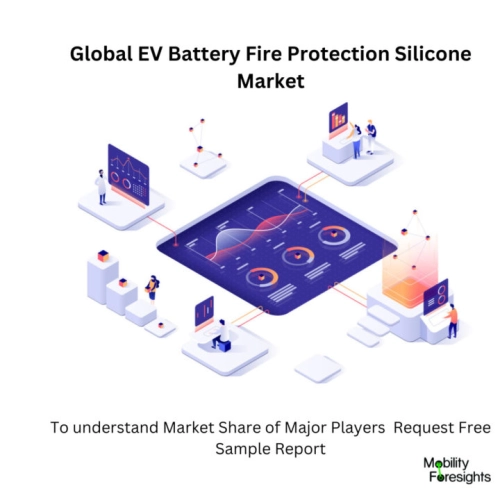
- Get in Touch with Us

Last Updated: Apr 25, 2025 | Study Period: 2023-2030
Electric vehicle batteries are protected from fire by an EV battery insulation pad. Thermal insulation pads provide protection for EV batteries against heat, fire, compression, water proofing, impacts, vibrations, collision, and severe environmental thermal runaway.
Both the safety of the vehicle's occupants and an electric car battery depend on effective heat control. Due to their thermal, electrical, and chemical resistance, silicone and Nomex are well-known materials that are utilised in EV and HEV components. Strong atomic bonding between silicon and oxygen give silicone its great heat stability and oxidation resistance.

The Global EV Battery Fire Protection silicone market accounted for $XX Billion in 2022 and is anticipated to reach $XX Billion by 2030, registering a CAGR of XX% from 2023 to 2030.
Wacker developed specialised silicone for EV battery fire prevention. Silicone is a synthetic polymer that is resistant to large temperature fluctuations and is made of silicon, oxygen, and other elements found in nature.
It contributes to preserving the ideal battery temperature and boosting EV stability. As EV vehicle sales increase globally, so does the demand for high-performance materials. Based on their current silicone portfolio, which includes ELASTOSIL, SEMICOSIL, and SilGel, Wacker created a silicone solution that is optimised for EV. To efficiently manage heat, silicone is applied in a variety of forms such as gap fillers, gels, adhesives, and pastes.
Lithium-ion batteries, which are mounted beneath the seat, are the primary power source for EVs. To properly transport the heat produced by the battery module to the heat cooling system of the pack, a gap filler with thermal conductivity is needed.
created a gap filler that doesn't produce bubbles when it's filling a gap in order to increase heat radiation in a tiny area of just a few hundred micrometres (m). It maximises manufacturing productivity with high flowability and quick application. Additionally improving battery safety is a silicone solution. The silicon-based coating used by Wacker is applied to the interior of the battery housing and hardens into ceramic when heated.
| Sl no | Topic |
| 1 | Market Segmentation |
| 2 | Scope of the report |
| 3 | Abbreviations |
| 4 | Research Methodology |
| 5 | Executive Summary |
| 6 | Introduction |
| 7 | Insights from Industry stakeholders |
| 8 | Cost breakdown of Product by sub-components and average profit margin |
| 9 | Disruptive innovation in the Industry |
| 10 | Technology trends in the Industry |
| 11 | Consumer trends in the industry |
| 12 | Recent Production Milestones |
| 13 | Component Manufacturing in US, EU and China |
| 14 | COVID-19 impact on overall market |
| 15 | COVID-19 impact on Production of components |
| 16 | COVID-19 impact on Point of sale |
| 17 | Market Segmentation, Dynamics and Forecast by Geography, 2023-2030 |
| 18 | Market Segmentation, Dynamics and Forecast by Product Type, 2023-2030 |
| 19 | Market Segmentation, Dynamics and Forecast by Application, 2023-2030 |
| 20 | Market Segmentation, Dynamics and Forecast by End use, 2023-2030 |
| 21 | Product installation rate by OEM, 2023 |
| 22 | Incline/Decline in Average B-2-B selling price in past 5 years |
| 23 | Competition from substitute products |
| 24 | Gross margin and average profitability of suppliers |
| 25 | New product development in past 12 months |
| 26 | M&A in past 12 months |
| 27 | Growth strategy of leading players |
| 28 | Market share of vendors, 2023 |
| 29 | Company Profiles |
| 30 | Unmet needs and opportunity for new suppliers |
| 31 | Conclusion |
| 32 | Appendix |